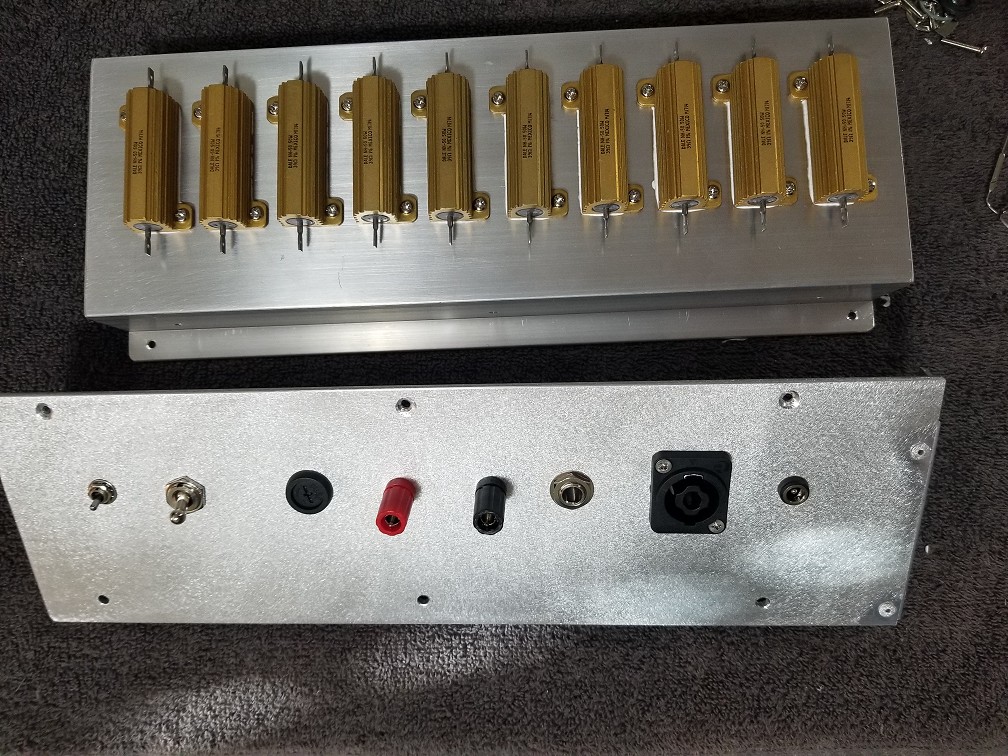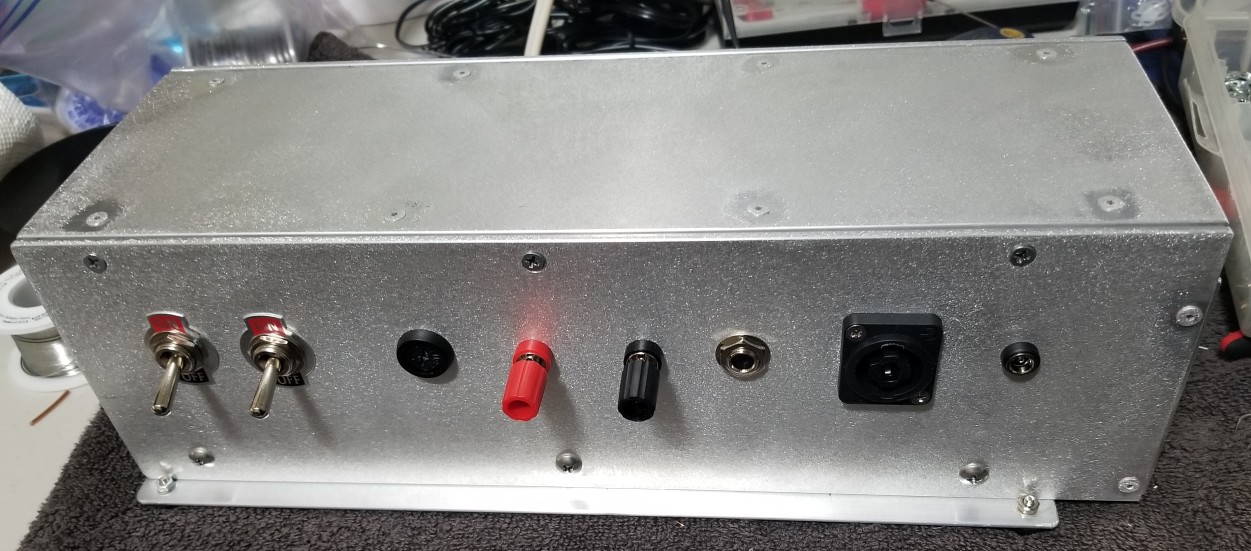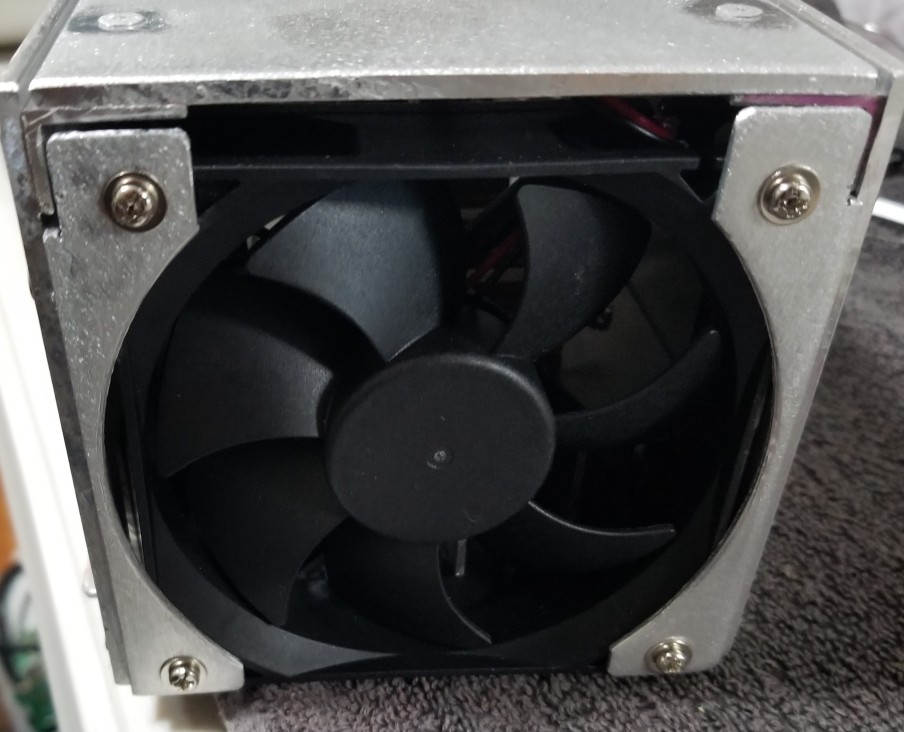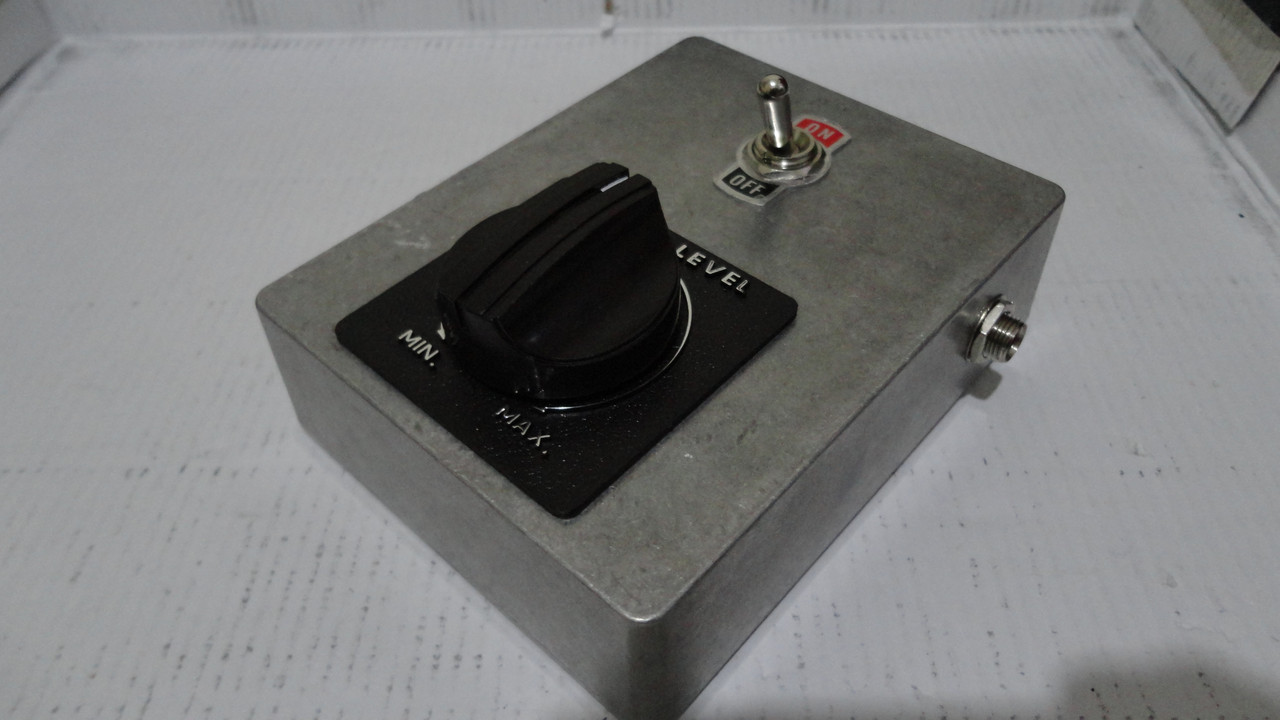Page 1 of 2
Dummy load for amplifier testing
Posted: Sat Oct 30, 2021 6:14 pm
by laurie
I've been working on a few amplifiers the last year or two. I used to have a very dodgy dummy load made from eight 3R9 10W resistors - it was an 80W load at 7.8 Ohms. However, the resistors were normal "wire wound" so the load was highly inductive, and 80W isn't much power so it got hot. A lot.
The old dummy load fell apart last week (literally - the resistors crumbled from age and overheating).
Dummy loads are really useful - testing the actual output power of an amp before clipping, for amps that have a fan you can load them down and make sure the fan comes on when they are hot enough, etc.
I decided to make something more professional. The pic below shows my new amp testing dummy load.
It is ten 39R 50W non-inductive resistors (Ayrton-Perry windings) on a robust heatsink. The heatsink is rated at 0.625 °C/W free air, and an added fan should lower that to less than 0.2 °C/W. The load will be 250W+ at 7.8 Ohms (5 resistors in parallel), and 500W+ at 3.9 Ohms (adding the other 5 in parallel).
If you have an interest I can show the assembly pics and post the schematic?
.

- Dummy_load.jpg (272.36 KiB) Viewed 5656 times
Re: Dummy load for amplifier testing
Posted: Sat Oct 30, 2021 10:14 pm
by Old_Iron
laurie wrote: ↑Sat Oct 30, 2021 6:14 pm
If you have an interest I can show the assembly pics and post the schematic?
Sure Laurie, please do it.
I'm after a good DIY dummy load for my JCM800 for eons now.
Made a L-Pad 20 watts for my DIY single ended one tube power amps, but it "eats" the high frequencies too much if you attenuate past half point.
Up until today, the best solution I know is the Boss waza tube amp expander, but I didn't like the color of it, too much "green" ($$$) for my taste.

Re: Dummy load for amplifier testing
Posted: Sun Oct 31, 2021 3:10 am
by laurie
This could easily be the basis of a high-power L-Pad... would need another bank of resistors. Shouldn't suck any frequencies because the resistors are non-inductive.
Re: Dummy load for amplifier testing
Posted: Sun Oct 31, 2021 7:33 pm
by laurie

- 20211031_084352sml.jpg (189.55 KiB) Viewed 5623 times
.

- 20211031_091708SML.jpg (189.3 KiB) Viewed 5623 times
.

- 20211031_091715SML.jpg (107.39 KiB) Viewed 5623 times
Re: Dummy load for amplifier testing
Posted: Sun Oct 31, 2021 7:33 pm
by laurie

- 20211031_091722SML.jpg (140.17 KiB) Viewed 5623 times
.

- Label1.jpg (45.7 KiB) Viewed 5623 times
Re: Dummy load for amplifier testing
Posted: Sun Oct 31, 2021 7:37 pm
by laurie
Three input options:
- Banana sockets/speaker binding posts
Fan jack has bridge rectifier on the back of the socket so it doesn't matter what polarity the power supply is. I have a fan guard on order that I'll fit when it comes.
Switches give:
- 2 resistors in parallel - 19.5 Ohm at 100W for testing tube amps with 16 Ohm output.
- 5 resistors in parallel - 8 Ohms
- 7 resistors in parallel - 6 Ohms
- 10 resistors in parallel - 4 Ohms
Fuse is just good practice. It should never blow unless a resistor fails.
Re: Dummy load for amplifier testing
Posted: Fri Nov 05, 2021 6:39 pm
by Old_Iron
laurie wrote: ↑Sun Oct 31, 2021 7:37 pm
Three input options:
- Banana sockets/speaker binding posts
Fan jack has bridge rectifier on the back of the socket so it doesn't matter what polarity the power supply is. I have a fan guard on order that I'll fit when it comes.
Switches give:
- 2 resistors in parallel - 19.5 Ohm at 100W for testing tube amps with 16 Ohm output.
- 5 resistors in parallel - 8 Ohms
- 7 resistors in parallel - 6 Ohms
- 10 resistors in parallel - 4 Ohms
Fuse is just good practice. It should never blow unless a resistor fails.
Laurie I'm very sorry I only saw your posts today, that's because I only look at the board index page for new posts and since you posted at the same day, I though it was the same post I already read.
Thank you for sharing this project, I will study it and build it.
Please give us a small review of the performance, does it works well?
What about the high frequencies and dynamics at maximum attenuation?
P.S.: Oh, I'm stupid, yeah I am.
I misunderstood from the beginning, it's a dummy load, not an attenuator.
Has been a wile since the last time I dealt with this kind of stuff and I "drifted in the mayonnaise".
Sorry again Laurie, I'm getting old and ga-ga too fast.
Re: Dummy load for amplifier testing
Posted: Fri Nov 05, 2021 9:11 pm
by laurie
With a second bank of resistors it can become an attenuator.
OR
I'm interested now to build an attenuator. If it is only for a tube amp, it can be much smaller and less expensive. The dummy load can sink between 500W and 1000W. Only 100W for an attenuator.
I'll figure out the components needed and likely build one over the winter.
Frequency response and dynamics should be good with the "right" resistors.
Re: Dummy load for amplifier testing
Posted: Fri Nov 05, 2021 9:28 pm
by Old_Iron
laurie wrote: ↑Fri Nov 05, 2021 9:11 pm
With a second bank of resistors it can become an attenuator.
OR
I'm interested now to build an attenuator. If it is only for a tube amp, it can be much smaller and less expensive. The dummy load can sink between 500W and 1000W. Only 100W for an attenuator.
I'll figure out the components needed and likely build one over the winter.
Frequency response and dynamics should be good with the "right" resistors.
I have a few documents about attenuators from when I was into the subject, I will compact then into a .rar file and send it to you via email.
Sent, not much, just a couple of simple ones that I was thinking to build, but in the end did only a L-Pad, a high frequency sucker:


Re: Dummy load for amplifier testing
Posted: Fri Nov 05, 2021 11:32 pm
by laurie
The tight loops in that wire-wound potentiometer are very high inductance. Guaranteed to suck high frequencies.
I'll have a different approach.
Thanks for the file!

